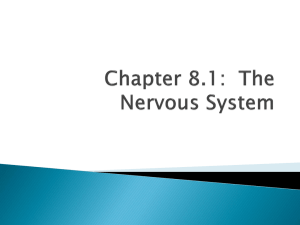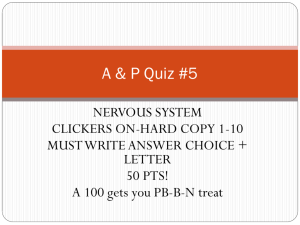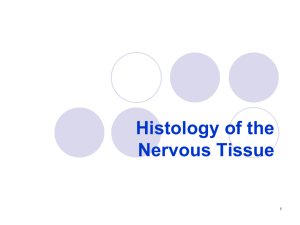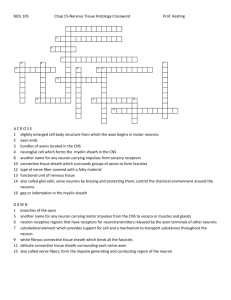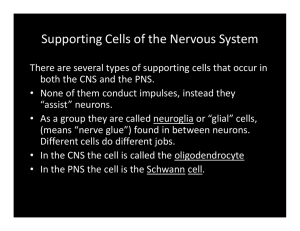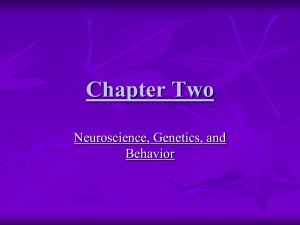AP Biology Nervous System Part 1 Outline
advertisement
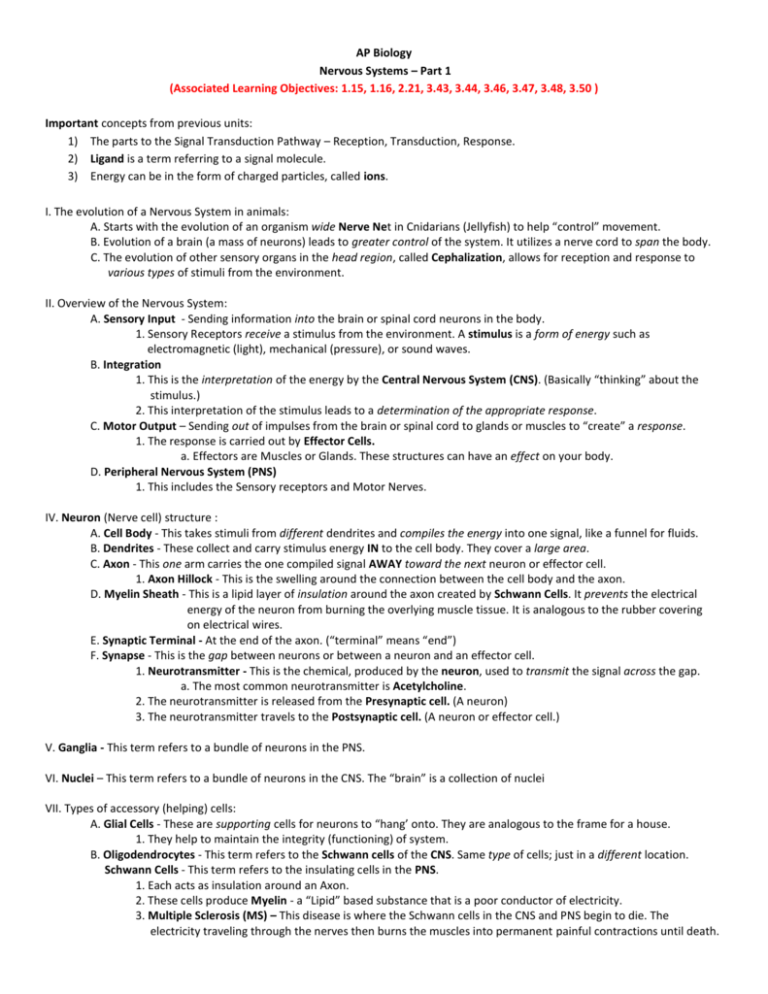
AP Biology Nervous Systems – Part 1 (Associated Learning Objectives: 1.15, 1.16, 2.21, 3.43, 3.44, 3.46, 3.47, 3.48, 3.50 ) Important concepts from previous units: 1) The parts to the Signal Transduction Pathway – Reception, Transduction, Response. 2) Ligand is a term referring to a signal molecule. 3) Energy can be in the form of charged particles, called ions. I. The evolution of a Nervous System in animals: A. Starts with the evolution of an organism wide Nerve Net in Cnidarians (Jellyfish) to help “control” movement. B. Evolution of a brain (a mass of neurons) leads to greater control of the system. It utilizes a nerve cord to span the body. C. The evolution of other sensory organs in the head region, called Cephalization, allows for reception and response to various types of stimuli from the environment. II. Overview of the Nervous System: A. Sensory Input - Sending information into the brain or spinal cord neurons in the body. 1. Sensory Receptors receive a stimulus from the environment. A stimulus is a form of energy such as electromagnetic (light), mechanical (pressure), or sound waves. B. Integration 1. This is the interpretation of the energy by the Central Nervous System (CNS). (Basically “thinking” about the stimulus.) 2. This interpretation of the stimulus leads to a determination of the appropriate response. C. Motor Output – Sending out of impulses from the brain or spinal cord to glands or muscles to “create” a response. 1. The response is carried out by Effector Cells. a. Effectors are Muscles or Glands. These structures can have an effect on your body. D. Peripheral Nervous System (PNS) 1. This includes the Sensory receptors and Motor Nerves. IV. Neuron (Nerve cell) structure : A. Cell Body - This takes stimuli from different dendrites and compiles the energy into one signal, like a funnel for fluids. B. Dendrites - These collect and carry stimulus energy IN to the cell body. They cover a large area. C. Axon - This one arm carries the one compiled signal AWAY toward the next neuron or effector cell. 1. Axon Hillock - This is the swelling around the connection between the cell body and the axon. D. Myelin Sheath - This is a lipid layer of insulation around the axon created by Schwann Cells. It prevents the electrical energy of the neuron from burning the overlying muscle tissue. It is analogous to the rubber covering on electrical wires. E. Synaptic Terminal - At the end of the axon. (“terminal” means “end”) F. Synapse - This is the gap between neurons or between a neuron and an effector cell. 1. Neurotransmitter - This is the chemical, produced by the neuron, used to transmit the signal across the gap. a. The most common neurotransmitter is Acetylcholine. 2. The neurotransmitter is released from the Presynaptic cell. (A neuron) 3. The neurotransmitter travels to the Postsynaptic cell. (A neuron or effector cell.) V. Ganglia - This term refers to a bundle of neurons in the PNS. VI. Nuclei – This term refers to a bundle of neurons in the CNS. The “brain” is a collection of nuclei VII. Types of accessory (helping) cells: A. Glial Cells - These are supporting cells for neurons to “hang’ onto. They are analogous to the frame for a house. 1. They help to maintain the integrity (functioning) of system. B. Oligodendrocytes - This term refers to the Schwann cells of the CNS. Same type of cells; just in a different location. Schwann Cells - This term refers to the insulating cells in the PNS. 1. Each acts as insulation around an Axon. 2. These cells produce Myelin - a “Lipid” based substance that is a poor conductor of electricity. 3. Multiple Sclerosis (MS) – This disease is where the Schwann cells in the CNS and PNS begin to die. The electricity traveling through the nerves then burns the muscles into permanent painful contractions until death.

